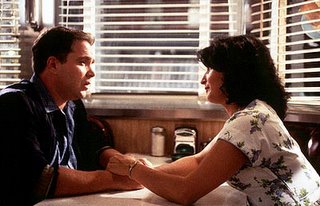
Two Family House (2000)
Director: Raymond De Felitta
As I was browsing the library shelves one day, looking for something light and interesting to watch, I came across a movie called Two Family House. The box advertised that the film won the Audience Award at the 2000 Sundance Film Festival, so I figured I wouldn't be taking too much of a risk in borrowing it--particularly since it was a library freebie. After I finished watching it, the glowing reviews of the movie by Roger Ebert and some other critics came back to me. In between, I had one of my best film-viewing experience in weeks.
The film, which takes place on New York's Staten Island, revolves around Buddy Visalo (Michael Rispoli), an Italian-American WWII veteran who returns home after the war and does what GIs did back then--get married and carve a piece of the American Dream out for themselves. But Buddy isn't just looking for a bread-and-butter job and a cozy bungalow. During the war, radio entertainer and soon-to-be TV host Arthur Godfrey heard Buddy sing to the troops and invited him to audition for his show when he came home. Buddy has nursed this dream all during his tour of duty and is convinced that this could be his shot at the big time. Buddy's fiancee, Estelle (Katherine Narducci), thinks otherwise and pushes Buddy toward safety and security.
By 1956, the year the film takes place, Buddy and Estelle have been married f
 or nearly 11 years. Buddy works in a factory, and the couple still lives in his in-laws' house. His dream of making something of himself has not died, however. After several losing business ventures, Buddy buys a dilapidated two-flat and decides to convert the first floor into a tavern and live on the second floor. First, however, he has to evict the Irish tenants who are living on the second floor, the O'Nearys. Mary O'Neary (Kelly MacDonald) is young and pregnant. Jim O'Neary (Kevin Conway) is middle-aged, drunken, and abusive to Mary. Buddy has his work cut out for him dealing with Jim. Before he can toss them out, Mary gives birth to a half-black baby, obviously not Jim's, and Jim walks out on her forever. A sympathetic Buddy decides to let Mary stay on for a while, and he starts to help her out with odd jobs and the occasional friendly chat.
or nearly 11 years. Buddy works in a factory, and the couple still lives in his in-laws' house. His dream of making something of himself has not died, however. After several losing business ventures, Buddy buys a dilapidated two-flat and decides to convert the first floor into a tavern and live on the second floor. First, however, he has to evict the Irish tenants who are living on the second floor, the O'Nearys. Mary O'Neary (Kelly MacDonald) is young and pregnant. Jim O'Neary (Kevin Conway) is middle-aged, drunken, and abusive to Mary. Buddy has his work cut out for him dealing with Jim. Before he can toss them out, Mary gives birth to a half-black baby, obviously not Jim's, and Jim walks out on her forever. A sympathetic Buddy decides to let Mary stay on for a while, and he starts to help her out with odd jobs and the occasional friendly chat. At first, this arrangement seems just the decent thing to do, but slowly, the prejudices of the Italian-American community start to crowd in on Mary and, eventually, on Buddy. The bald-faced prejudices of the time are on full display. They are a bit shocking to modern sensibilities, but we also see that Buddy has his problems with his social milieu as well that extend beyond his wife's play-it-safe lack of confidence in him and his friends' well-intentioned attempts to support his dreams without providing him with an example of courage he can truly lean on. Buddy feels isolated and alienated; only Mary truly listens to him and believes in him. Mary's courage strengthens Buddy, and they become allies in attempting to make their own lives apart from the expectations of their social groups and the constricting 1950s.
This film is tightly paced, with well-drawn characters of real complexity and truth. It's instructive that rebellions could occur at a time when conformity was the norm, and that those rebellions would be in simple acts of the upwardly mobile working class as well as the more "usual suspect" of 1950s rebellion. I very highly recommend this touching, wonderfully written, acted, and directed indie film. l


0 Comments:
Post a Comment
<< Home